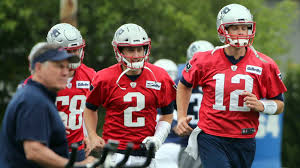\Note: This is the fifth in a series of six articles on how to approach the quarterback position in a 2QB or Superflex league. The overall strategy article appears here. The second article, “The Multiple Stud QBs Approach”, appears here. The third article, “The QB Value Approach”, appears here. The fourth article, “The Scrubs Approach”, appears here.
Minimally, winning major league baseball teams look to have a bona fide #1 starting pitcher, a winning #2 starting pitcher, and productive #3 starting pitcher, a dependable #4 starting pitcher, and an innings-eater or upside #5 starting pitcher.
You can approach the quarterback position in Superflex and 2QB leagues the same way: Draft a QB1, a QB2, a QB3, and a late-round veteran or back-up for your bench. You’ll have productivity everywhere, a fill-in if necessary, and plenty of capital to spend on other premium players.
Let’s continue with the SWOT analysis for our Balanced Approach to QB roster construction possibilities.
Strenghts:
- Balanced, competitive QBs. You’ll always have a QB1 and a QB2 to play, making you competitive every week at the quarterback position.
- Balanced team. By not allocating too much on QBs, you can distribute your resources evenly elsewhere, helping you to maintain a balanced and powerful team. You don’t have to sacrifice production elsewhere to be competitive at QB.
Weaknesses:
- Unlikely to dominate. Being able to dominate at the most important position would give anyone a considerable edge. You are eschewing that possibility.
- Susceptible to variance. With only one QB1, one QB2, and a couple of QB3s or flyers, you are going to experience week-to-week variance throughout the season (e.g., if your QB1 has a poor week).
Opportunities:
- Well-rounded team. It’s hard to win a championship without productive players everywhere. You can round out your team without sacrificing essential QB scoring.
- Never scrambling. Because you have all your QB roles filled, you’re never scrambling out of desperation to fill in a quarterback slot and potentially overpaying to do so.
Threats:
- No replacement-level depth. When a player goes down with injury or has his bye week, you want to be confident that you can at least come close to his production. That won’t be the case here.
- Trade freeze. With minimal depth, it can be hard to cash in on a quarterback value spike without creating a difficult-to-fill hole in your line-up.
The Balanced Approach can be key in creating a well-rounded team that is competitive at every position. While other teams spend their capital — and time! — trying to get the slightest QB edge, you’ll be able to pick up extra scoring at every other position. Just hope that your guys stay healthy and meet expectations!
Targets: Not any specific player(s). Take one player in each QB tier — either a stud that you like or a value player that you’re high on.
Next week: The Hoarding Approach



